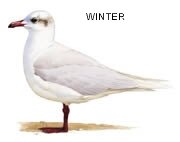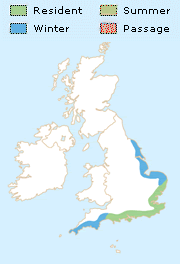You may have become aware that we that we are getting rather excited about our Mediterranean Gull sightings on our bird report pages. One of the reasons for this is that these gulls were, until fairly recently, very scarce in Britain, we also feel that the Mediterranean Gull, when in breeding plumage, is undoubtedly one of our best looking gulls. The main population of these birds was traditionally centred on the Ukrainian Black Sea coast but in recent years we have seen a massive range expansion of these gulls. The first documented breeding in the UK was in 1968 and then it became a regular after 1976. In the 1980s large colour ringing projects have been undertaken in various countries which has allowed us to trace the origins of some of the birds that we have observed - these rings have allowed us to trace birds that initially bred in France, Germany, Holland, Denmark and even the Czech Republic! Ringed birds have given us much more information and, for instance, some observations seems to suggest that the Hungarian population move overland via the Danube to winter in Britain. Hungarian birds have regularly been seen at Copt Point in Kent which was one of the more important sites for these birds. We say 'was' because the number of birds that we have observed recently may surpass this area.

The Mediterranean Gull arrivals seem to peak in July and on into early August but can continue through to October. Birds are present all winter in the local area with some sites (i.e. the Pier) attracting good numbers.
From reports it would appear that the gulls in the Mediterranean are still spreading westwards and, If the pattern of the past few years continues, we can expect the Mediterranean Gull to become a very common site and the breeding population in Britain to dramatically increase. The Mediterranean Gull was a very rare UK bird until the 1950s.
Identification
Slightly larger than a black-headed gull, with an all-black head in the breeding season. Adults have white wing-tips and underwings, younger birds have more wing markings. It has a large, slightly drooped beak, bright red when adult. Adults have a complete moult between June and September and then have a partial moult to acquire their black hood between February and April. The bird often stands with its head hunched between its shoulders, in flight it can look heavy bodied and thick necked with fuller and rounder wing tips than Black-headed Gull.
Its present UK breeding population makes it an RSPB Amber List species because of the small number breeding in the UK. Many of the breeding sites are on nature reserves. In world terms this is a rare gull with a restricted distribution.
Where does it live?
Breeding: Marshes and lagoons near the coast. In the UK they tend to breed among Black-headed Gull colonies but have also occurred in Common Gull colonies in Scotland. Wintering: Favours traditional wintering sites in ports and harbours and around outfalls.
Where to see it
Mainly found along the east and south coasts of England. It usually breeds within Black-headed Gull colonies at coastal wetlands and in winter birds are frequently found along our coast from Leigh to Wakering.
What does it eat?
Insects, fish, offal and carrion.
What does it sound like?
A shrill rather tern like 'kee-eer' or Kaa-aar' call
![]()
Note: you may need to right-click this image and select 'save target as' to hear this call.
|
||
 |
Vital Statistics Eggs: 3 Incubation: 23-25 days Fledging: 35-40 days Maximum lifespan: 15 years Length: 36-38cm Wingspan: 92-100cm Weight: 230-280g Estimated UK breeding in 2001: 90 109 pairs |
Below are a selection of photographs taken of our local Mediterranean Gulls
by Steve Arlow of the Southend Ornithological Group
Adult Mediterranean Gull. Westcliff. 01/07/03
Pair of Adult Mediterranean Gulls. Westcliff Seafront 12/04/03
Pair of 2nd Summer Mediterranean Gulls. Westcliff Seafront 12/04/03
Adult Summer Mediterranean Gull. Westcliff Seafront 11/03/03
Mediterranean Gull (A00, French Bird). Southend Pier 01/03/03
Mediterranean Gull (Czech Bird). Southend Pier 01/03/03
Mediterranean Gull (1st summer). Southend Pier 01/03/03
Mediterranean Gull (Adult winter). Southend Pier 01/03/03
2nd Winter Mediterranean Gull. Southend Pier 01/01/03
Colour Ring Information and Origins
Sky-blue ring with code (1 letter (R) and 2 numbers) - Germany
Until 1999 some 145 rings have been placed from which 85 light-blue and 23 green). Note: The sky-blue ring, after a while, can turn into 'white', therefore green rings have been used since 1999. A first letter is used A,C,M, E,H,J and a second letter is used A,C,EH,J,K,L,M,N,P,R,T,V,W,X,Y. A number is used 1 till 9, but the number 0 is not used.
White ring with code (2 numbers and 1 letter, 1 number and 2 letters since 1999) - The Netherlands.
White ring on the left leg (ringed as pulli),white ring on the right leg (ringed as adult).
Green ring with white code (letter A, C or J, E, and P and 2 numbers) - France.
Green ring with white code (letter R and 3 numbers) - France.
Green ring with white code (2 numbers and 1 letter (A,E,J,K,L,M,R,T,U,Y)) - Belgium.
Green ring with white code (3-letter-letter-number) - Belgium.
Black ring with white code (letter U (horizontal) and 3 numbers (vertical) and Black ring with white code (number-letter-number or number-number-letter or letter-number-letter) - Belgium.
The French and the Belgian projects have been running since 1991 and 2000. Around 850 and 750 green rings have been used respectively in France and Belgium until 2001. Codes used in the North of France : C00 - C99, E00 - E99, J00-J99 , R201-R00 , A00-A99 , H00-H99 (*), K00-K99, L00-L63 ; in the Camargue : 0A0-9A9 , 0C0-9C9 , T00-T99. During 2002 rings starting with number 3 have been used. These rings should be read from the bottom to the top. Used letters in the letter-combination are: A, C, E, H, J, K, L, M, N, P, R, T, U, V, W. Pay very special attention to the letters M and W, K and R and P and the numbers 0, 6 , 8 and 9. Rings with the numbers 6 and 9 have been fitted on the other leg than the rest of the codes.
Yellow ring with code (2 numbers/1 letter) - United Kingdom.
Red ring with white code (letter (P) and two numbers) or number/letterP/number) - Poland.
Red ring with white code (3E1-5E0 ; S01-S99) - Slovak Republic.
Red ring with white code (81A-92A ; 7E1-7E9 ; 01E-50E) - Czech Republic.
Red ring with white code (letter (H) and 3 numbers) and Red ring with white code (4 or 3 alphanumeric code) - Hungary.
Dark-blue ring with white code (1 letter and 2 numbers) and Dark-blue ring with white code (4 letters, the first is always I) - Italy.
Note: Please report all sightings of Mediterranean Gulls to us and especially any colour ringed birds that you may observe.
Postscript:
The Latin name for the Mediterranean Gull is 'Larus melanocephalus', which rather confusingly means Black-headed Gull Our common Black-headed Gull actually has a dark brown head!
 Example of a postage stamp issued in Gibralter depicting Mediterranean Gulls
Example of a postage stamp issued in Gibralter depicting Mediterranean Gulls
Page last updated:
Web Design Graham Mee. © Copyright of all pages South East Essex RSPB Local Group. All images copyright of owners
The Royal Society for the Protection of Birds. Registered charity no 207076
Please read our cookie, privacy and visitor policy

